What Is a Marketing Plan? How To Create One: Ultimate Guide

I’ve spent years developing marketing plans for product launches, campaigns, and even company-wide projects. And along the way, I’ve learned what needs to be included, what can be left out, and how to keep your plan actionable.
In this guide, I’ll share all that experience with you. We’ll walk through how to write a marketing plan, why you need one, and the mistakes to avoid when writing one.
I will also share with you a sample marketing plan and how you can use project management software like Wrike to simplify your planning process and keep your whole team aligned.
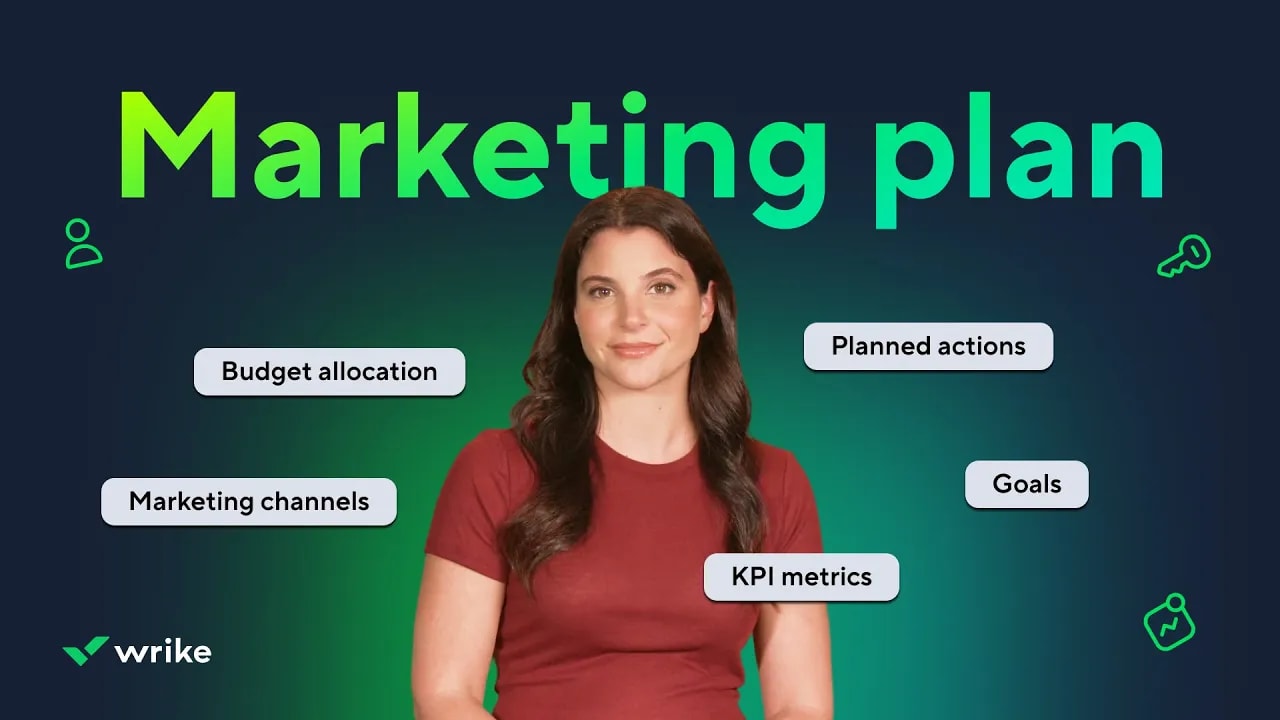
What is a marketing plan?
A marketing plan is a document that outlines your marketing strategy, clearly showing your goals, target audience, specific actions, and how you’ll measure success. It guides your marketing efforts over a set time, typically one year, helping your team stay aligned and focused on achieving your business objectives.
Why you need a marketing plan
I’m often asked by marketing leaders: “Do we always need to write a marketing plan?” And my answer is always simple: Absolutely! But let me explain why.
A marketing plan is your clear action guide. Without one, your marketing efforts can quickly become scattered, and you risk spending resources without knowing exactly what’s working (and what’s not).
When you have a marketing plan, attracting new customers becomes much simpler because you already understand your ideal target audience. This clarity naturally boosts how well you connect with your target market, creating stronger relationships from day one.
Marketing plan frameworks
A solid marketing plan needs structure. Over the years, I’ve worked with different marketing frameworks, but these three are the most effective for building an actionable strategy.
The 4 Ps framework
The 4 Ps is a classic marketing mix that I still rely on, especially for product-focused strategies:
- Product: What are you selling, and why does it matter?
- Price: What’s the pricing strategy? Does it reflect value and demand?
- Place: How will customers find and buy your product?
- Promotion: What marketing tactics will you use to drive awareness and sales?
The 7 Ps framework
This model expands on the classic 4 Ps by adding key factors that influence modern marketing strategies:
- Product: What are you selling? How does it solve a problem?
- Price: Is your pricing competitive?
- Place: Where do customers find your product?
- Promotion: How will you market your product?
- People: Who interacts with your customers?
- Process: How does your business operate to ensure efficiency?
- Physical evidence: What tangible proof (packaging, branding, reviews) reassures customers?
You can use this marketing mix when working on service-based businesses, where customer experience plays a huge role in success.
The 5 Cs framework
If you need a broader market analysis before creating a marketing strategy, turn to the 5 Cs:
- Company: What are your strengths, weaknesses, and unique selling points?
- Customers: Who is your target audience, and what do they need?
- Competitors: Who are you up against, and how do you differentiate?
- Collaborators: What partnerships, suppliers, or distributors can support your strategy?
- Climate: What external factors (economic, social, technological) affect your business?
A plan without measurement is just a shot in the dark, and I prefer having clear data to guide decisions. That’s why tracking key performance indicators (KPIs) is important.
What are KPIs in a marketing plan?
Key performance indicators (KPIs) measure the performance of your marketing plan. They provide data-driven insights to track progress and optimize your marketing strategy for better results.
Common KPIs include:
- Lead generation: Number of new leads, conversion rates, cost per lead
- Brand awareness: Website traffic, social media reach, ad impressions
- Engagement: Click-through rates, social media interactions, email open rates
- Sales and revenue: Customer acquisition cost, revenue growth, return on ad spend
- Customer retention: Repeat purchase rates, churn rate, customer lifetime value
Speaking of KPIs, you can visualize your KPIs in a way that makes sense for your team with Wrike. Use our Table view to see your work in a spreadsheet format without switching to Excel or Google Sheets.


What is in a marketing plan?
What exactly goes into a marketing plan? I’ll walk you through how I’ve approached creating a marketing plan from my years of experience.
Executive summary
The executive summary is essentially your marketing plan in a nutshell. Even though it’s the first section, it’s usually the last thing I write. That might sound strange, but it actually makes perfect sense. By the time you finish your entire marketing strategy, you’ll know exactly how to summarize everything clearly.
A good executive summary quickly answers important questions like:
- What are your overall goals?
- Who exactly are you trying to reach?
- How do you plan to reach them?
- What outcomes do you expect?
For instance, if we’re launching a new digital marketing campaign, my summary outlines the main objectives, key marketing channels, positioning strategy, and the primary target customers.
Content formats
Clearly defining the content formats you’ll use makes everyone’s job easier. Deciding upfront prevents confusion later on. Depending on your marketing objectives, your content format could be:
- Short-form videos
- Email sequences
- Live webinars
- Podcasts
- Infographics
- Blog articles
Speaking of content formats, you can use Wrike’s Work Intelligence® to generate briefs and plans, and brainstorm ideas for your campaign.


Target audience
One of the first mistakes I see global marketers make is not researching their target audience even before creating the product/service. I’ve learned from experience that understanding your target market makes your entire marketing strategy much stronger.
You can’t effectively market without knowing who you’re marketing to. When I create plans, I always invest considerable time in market research.
This means identifying the demographics of our ideal customers. These include:
- Age
- Occupation
- Location
- Interests
- Behaviors
- Values
Why is this important? Because knowing your target audience allows you to speak their language, create content they’ll genuinely engage with, and choose the right marketing channels.
Goals
Setting clear marketing goals keeps your entire team moving in the right direction. Your goals should always tie directly into your broader business plan.
Here’s how I typically structure my goals: If we’re trying to grow our market share, I clearly set a percentage target, like “increase market share by 15% within 12 months.” If we’re aiming to attract new customers, I put down specific numbers, such as acquiring 500 new leads from our digital marketing efforts within six months.
Another goal could be boosting customer interaction rates on our social media platforms by 20%. When your marketing team has specific goals like these, they know what’s expected and can measure their progress.
To keep these goals on track, Wrike’s OKR (objectives and key results) software can help you set measurable objectives and align tasks with your priorities.


Marketing channels
Who defines your marketing channel? Simple answer: your target audience. Instead of spreading your resources thinly, focus your marketing efforts on channels that directly match your audience’s preferences.
Examples of marketing channels include:
- Social media marketing
- Email marketing
- Search engine optimization
- Direct mail
- Event marketing
- Content marketing
- Influencer marketing
SWOT analysis
I always prioritize doing a thorough SWOT analysis because it gives you clarity on your business position. A SWOT analysis helps you understand your internal strengths and weaknesses, as well as external opportunities and threats.
For example, let’s say you’re creating a marketing plan for a popular local coffee shop chain that’s planning to expand by opening two new locations this year. The business has a loyal local following, relies heavily on various digital marketing strategies, and is interested in attracting new customers through targeted promotions.
Here’s what your SWOT analysis might look like:
Strengths:
- Strong local brand recognition
- Experienced marketing team
- Active and engaging social media presence
- Unique selling proposition of locally sourced, freshly roasted coffee
Weaknesses:
- Limited marketing budget
- Generic value proposition
- Low market share
- Outdated marketing materials
Opportunities:
- Increasing popularity of coffee culture among younger audiences
- Leveraging social media platforms for promotions
- Hosting local events to attract new customers
- Using SEO marketing to boost website visibility
- Launching loyalty programs to attract new customers
Threats:
- Rising competition
- Economic downturn
- Negative customer reviews on social media
- Potential supply chain disruptions
Clearly outlining these helps you know exactly where to focus your marketing efforts and goals.
Marketing resources
Laying out your available resources can avoid a lot of stress down the line. Resources include budget, tools, technology, and the skills available within your marketing team.
To keep your project running smoothly, you can use project management software like Wrike to track available resources, manage workloads, and prevent bottlenecks.


What are the benefits of a marketing plan?
Now that we’ve covered all the important elements of a marketing plan, how does it benefit your organization? Are your marketing efforts scattered, leaving you unsure of what’s working?
Early in my career, I faced the same challenges until I discovered the clarity that comes from a well-built marketing plan. A marketing plan helps you:
Set clear direction
An effective marketing plan sets clear expectations and directions for your entire team. Without this clarity, even talented teams can struggle, working in silos or duplicating tasks. With a clear plan, your team knows what to focus on, minimizing confusion and improving productivity.
Maximize budget
Having a well-crafted marketing plan helps you manage your marketing costs. It prevents overspending on ineffective advertising campaigns or random experiments and helps your team prioritize investments that deliver measurable results. You can use the monthly budget template in Wrike to track your organization’s spending habits.
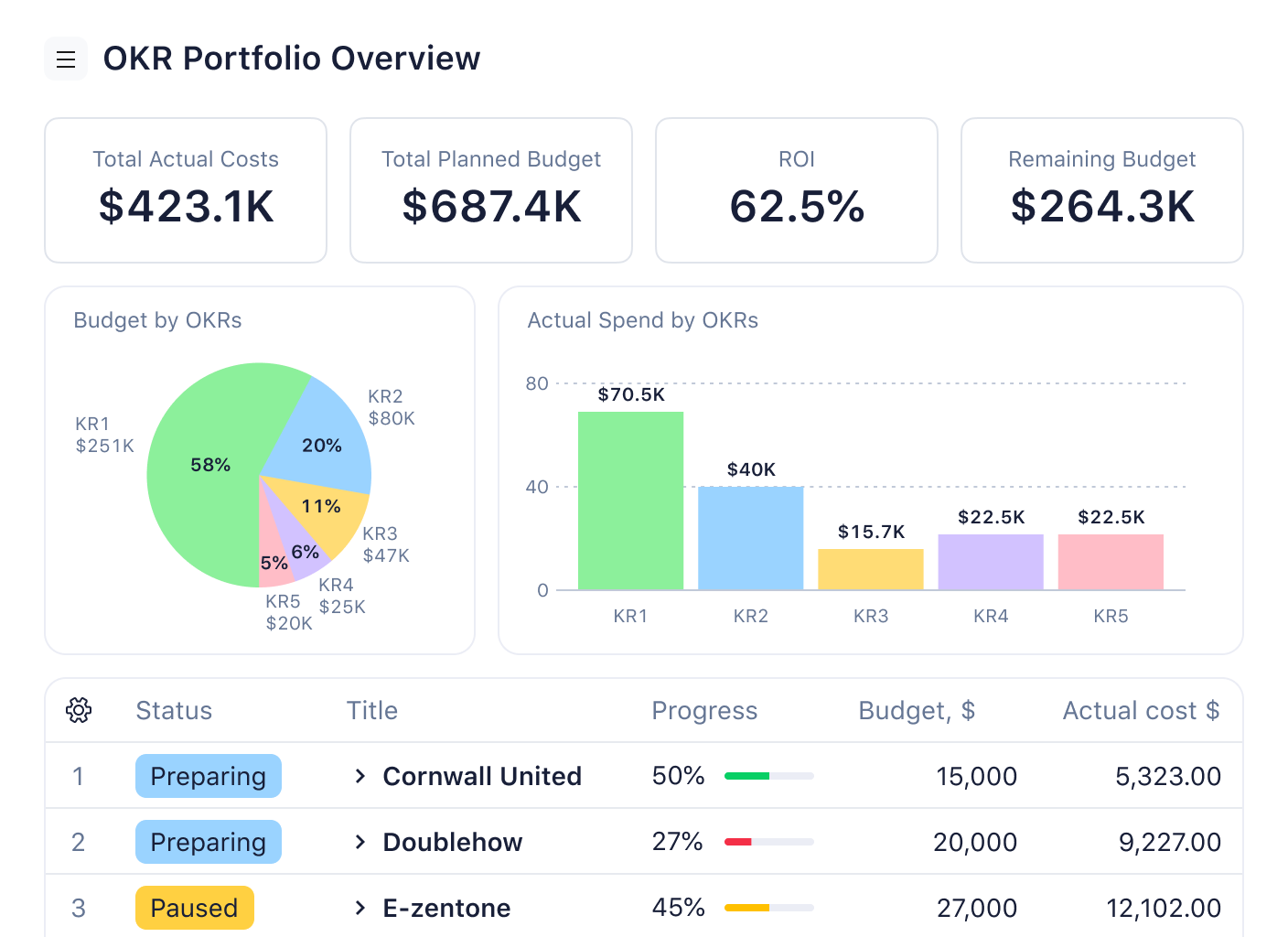

Understand your target audience
Every well-structured marketing plan involves thorough customer analysis. Understanding what resonates with your target market helps you tailor your marketing messages, refine your value proposition, and choose the right channels. It’s how you can consistently deliver marketing campaigns that connect with your target market.
Stay ahead of your competition
A marketing strategy often includes a competitive analysis, which helps you understand your market position compared to competitors. When teams understand external threats and industry dynamics, they can react proactively to changing marketing trends and competitive pressures.
When I build a marketing plan, I always start by considering the goal.
- What am I trying to achieve?
- Am I launching a new product?
- Expanding into a new target market?
- Refining an existing strategy?
Each situation calls for a different approach and, over the years, I’ve worked with various types of marketing plans that serve distinct purposes.
Some focus on brand awareness, while others are all about performance and conversions. The key is choosing the right plan that aligns with your business objectives and sets a clear path forward.
What are different types of marketing plans?
There are several different types of marketing plans that a company might choose to design in order to tackle a specific segment of potential customers or even to promote a new product or service.
Here’s a selection of some of the most common marketing plan types I have seen:
Product launch marketing plan
Launching a new product requires more than just announcing it. A product launch marketing plan builds excitement before launch day, drives early sales, and keeps momentum going after release. Without a plan, even great products can go unnoticed.
What does it include?
- Clear value proposition
- Pre-launch promotions and teasers
- Influencer outreach and PR efforts
- Launch-day events or offers
- Paid and organic advertising strategies
- Follow-up campaigns for continued engagement
- Customer feedback collection
Social media marketing plan
A social media marketing plan helps you grow and engage your audience across different platforms. Without a structured plan, businesses often post randomly without seeing real results.
What should it include?
- Posting schedule and content themes
- Paid advertising strategies
- Engagement tactics for community building
- Influencer and collaboration plans
- Crisis management strategy
Brand marketing plan
Brand marketing plans are designed to promote and elevate a company’s entire brand rather than a specific product or launch. They could involve activities like social media campaigns designed to build brand awareness or native advertising on blogs that help a segment of the customer base become more knowledgeable about the brand’s values and purpose.
SEO marketing plan
If you want more people to find your business online, an SEO marketing plan should be part of your overall business plan. It helps you rank higher in search engine results pages, increasing organic traffic without relying only on paid ads.
What’s included?
- Keyword research for high-ranking search terms
- Content strategy for blogs and landing pages
- On-page SEO optimization
- Link-building plans
- Performance tracking metrics
Traditional marketing plan
Not all marketing happens online. A traditional marketing plan focuses on offline strategies like print ads, radio, and events. This is still effective for businesses targeting local customers or industries where digital adoption is slower.
Digital marketing plan
Digital marketing plans are often designed as a separate component to other marketing plans because they include a range of channels in the digital or online space. Digital marketing plans include SEO optimization, PPC (pay-per-click) advertising, social media, and content marketing, among others.
So, we’ve talked about the different types of marketing plans, but how do you put one together? I’ve built and refined dozens of marketing plans, and one thing I’ve learned is that a plan only works if it’s clear, actionable, and flexible enough to adapt.
The next step is all about execution. Let me walk you through the steps needed to create a marketing plan.
How to create a marketing plan
Whenever I sit down to write a marketing plan, I treat it like building a roadmap. No one embarks on a journey without a clear route unless they want to waste time, get lost, or run out of fuel halfway. The same goes for marketing. Without a plan, budgets get drained, teams lose focus, and campaigns fall flat.
Here’s how I personally approach creating a marketing plan that works:
Step 1: Define your mission statement
I always start with the big picture: Why does this business exist, and what are we trying to achieve? Before jumping into any marketing strategy, I usually would write a defined mission statement that outlines our brand’s purpose. This is a direct statement that defines what you do, who you serve, and what makes your business unique.
Your mission should answer:
- What problem do you solve for customers?
- Who is your target audience?
- What sets you apart from competitors?
Once your mission statement is clear, set your strategic objectives. These should be measurable, time-bound goals that align with your overall business plan. For example, if you’re working on a marketing plan for a SaaS company, the mission might be:
“We help small businesses streamline invoicing and get paid faster with automated billing software.”
Once you have clarity here, set strategic objectives. Instead of vague goals like “Increase brand awareness,” get specific. For example: “Generate 1,000 qualified leads in the next 6 months through targeted email and content marketing.”
Step 2: Conduct a marketing audit
Before planning future marketing activities, analyze the current situation. A marketing audit helps you identify what’s working and what’s not. This includes reviewing past campaigns and evaluating your brand’s strengths and weaknesses.
Here’s what you should analyze:
- Where are our best customers coming from?
- What campaigns are generating ROI?
- Who are we up against, and how do we stand out?
- Are we overspending on low-impact activities?
- Do we have the right marketing tools and budget?
- What marketing funnel can we leverage?
For example, if I see that social media ads are bringing in tons of clicks but very few conversions, I know it’s time to refine our targeting or improve our landing pages.
Step 3: Outline your marketing strategy
Now that you know our goals and audience, it’s time to outline how you’ll achieve results. Your marketing plan outlines the specific actions you’ll take to achieve your goals.
- Will you focus on blog posts, video marketing, or case studies?
- What platforms will you use? How often will you post?
- Will you run paid ads, influencer marketing, or affiliate promotions?
- How will you nurture leads and maintain customer relationships?
Your marketing strategy should align with your audience’s habits. If your customers are professionals, LinkedIn might be better than Instagram. If they rely on search engines, an internet marketing strategy focusing on SEO might work best for such an audience.
Step 4: Set your marketing budget
Budgeting isn’t the fun part, but it’s essential. You need to make sure every dollar spent contributes to the bottom line. Do you have a marketing plan cost? Include it when creating your plan, as it helps to ensure you allocate funds wisely. Without a clear budget or marketing plan cost, businesses often overspend on low-impact activities while neglecting high-performing ones.
Consider costs for:
- Advertising (Google Ads, Facebook Ads, influencer collaborations)
- Marketing tools (CRM, automation software, email marketing platforms)
- Human resources
- Content creation (copywriting, graphic design, video production)
- Social media promotions and sponsored posts
- Event marketing and offline advertising
A good rule of thumb is to invest in channels that provide measurable ROI. If one advertising channel isn’t performing, simply reallocate that budget elsewhere.
Step 5: Align sales and marketing teams
Marketing and sales should work together, not separately. When marketing and sales teams collaborate, conversion rates improve, and customer relationships strengthen.
How do you align sales and marketing?
- Set shared goals for lead generation and conversion rates
- Define what qualifies as a “hot lead” and when to hand them off to sales
- Use a CRM to track customer interactions
- Ensure marketing content supports sales conversations
- Regularly review sales feedback to refine marketing messages
Step 6: Implement and track performance
Now, it’s time to execute. Your marketing plan is only effective if it’s properly implemented.
I use a marketing dashboard in Wrike to track progress, assign tasks, and manage timelines. You can also use the marketing plan template in Wrike, which you can test out during a free two-week trial to keep everything organized and ensure accountability.
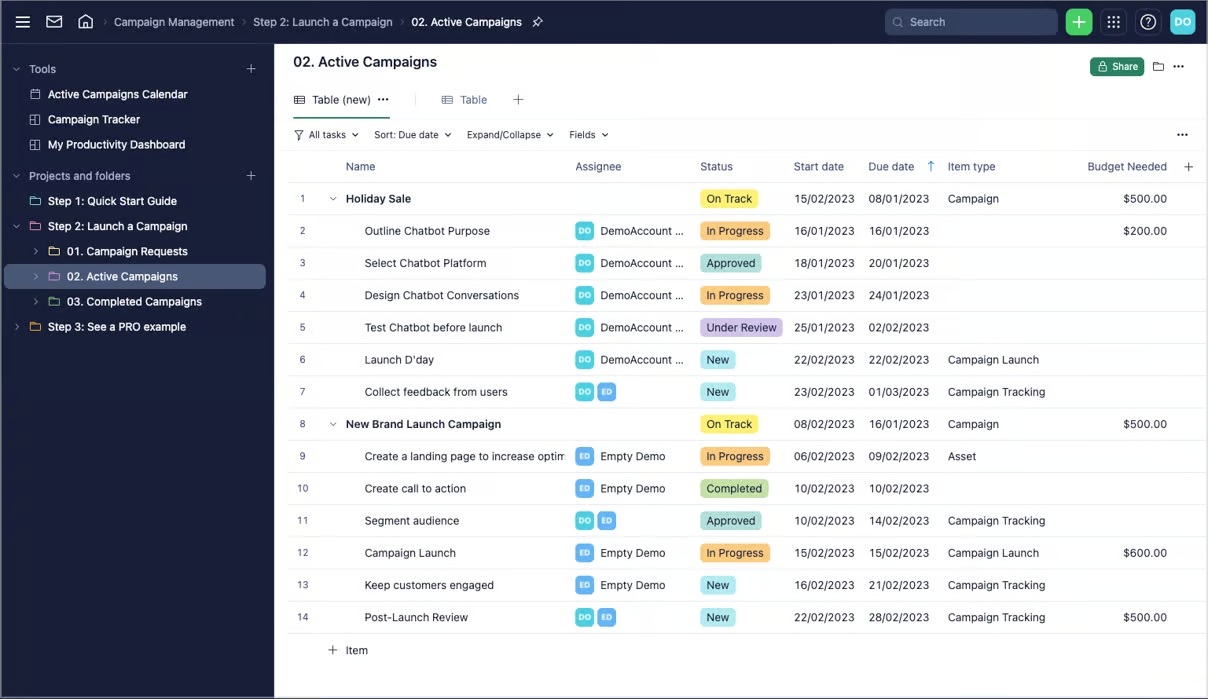

Step 7: Optimize and adjust your marketing plan
No successful marketing plan is set in stone. Continuous optimization is necessary to adapt to changing marketing trends, audience behaviors, and business goals.
How do you improve your plan?
- Analyze performance data
- Experiment with a new pricing strategy
- Adjust budget allocations based on ROI
- Update marketing funnel and branding as needed
- Stay ahead of competitors by following industry shifts
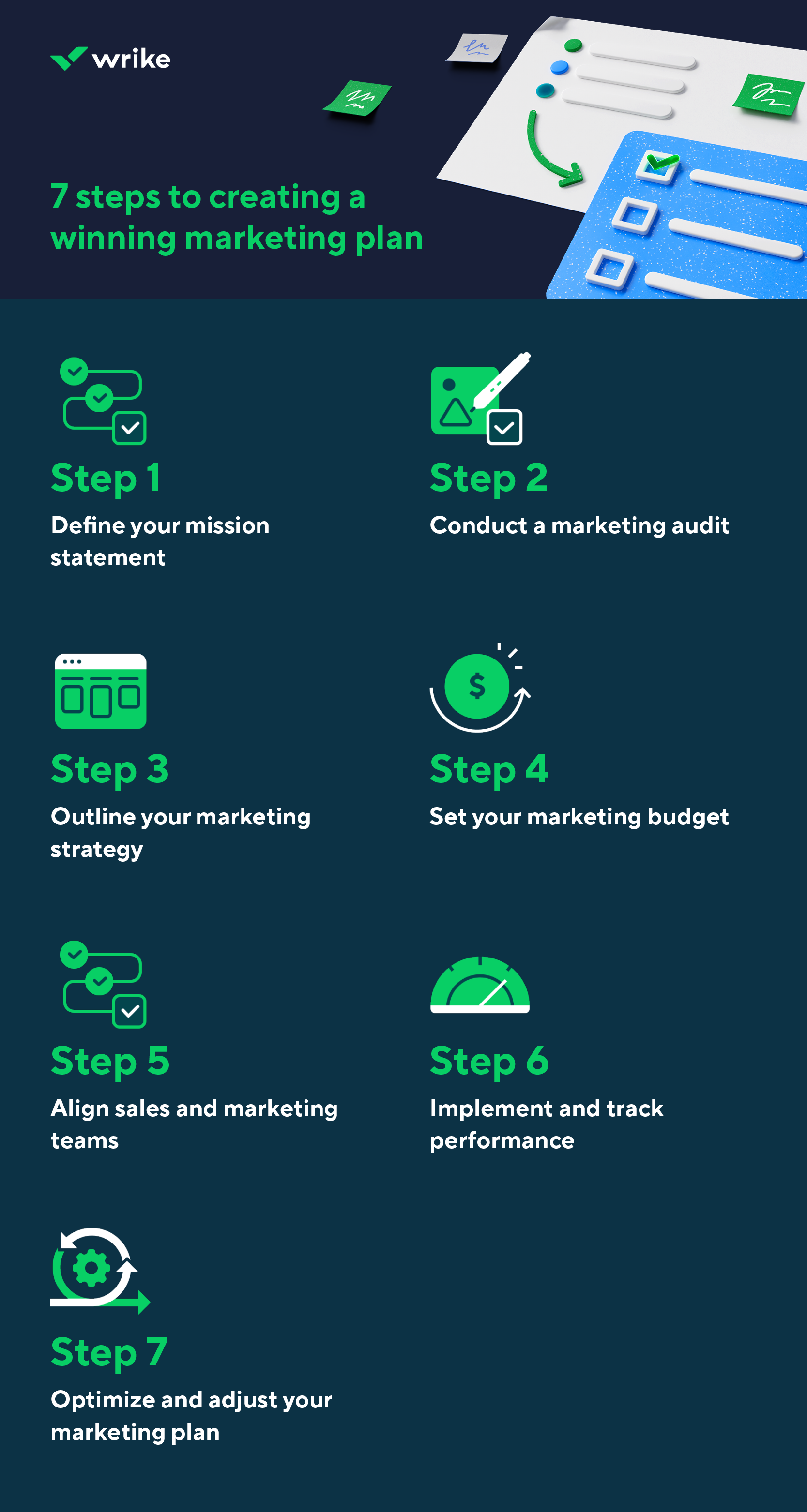

Real-world marketing plan examples
How do the best brands stay ahead? How do they drive marketing success? Let’s look at real-world examples of brands that built strong marketing plans and saw good results.
Visit Oxnard
Obstacles
Oxnard, California, was heavily impacted by the pandemic, with a major decline in both business and leisure tourism. The challenge was to rebuild interest in Oxnard as a travel destination while also attracting business conferences and film productions as a cost-effective alternative to Los Angeles.
Strategy
Oxnard created a business marketing plan, “Visit Oxnard,” that focused on these key areas:
- Business tourism and events
- Market segmentation
- A multichannel approach
Outcomes
Oxnard saw an increase in business-related visits and production projects, leading to economic recovery in the area.
Lesson learned
A marketing plan can help spot new opportunities in the market and strategically position your brand to fill gaps.
Check out the annual marketing plan here.
Dodo Pizza
Obstacles
Dodo Pizza is no ordinary pizza chain. Operating in 14 countries, including Russia, the U.S., China, and Europe, it runs on digital tools to optimize everything from online orders to supply chain logistics. Before Wrike, its marketing teams used Google Docs, Excel spreadsheets, and scattered checklists to track product launches. This resulted in data silos and lack of transparency.
Strategy
- Standardized marketing workflows: Using Wrike, Dodo Pizza created a marketing plan template for new product launches, ensuring consistency across locations.
- Cross-team collaboration: Marketing, R&D, and logistics teams worked within Wrike, improving transparency.
- Real-time tracking: The company used Wrike’s Gantt charts to visualize project timelines and avoid delays.
Outcomes
Dodo Pizza successfully streamlined marketing operations, cut down delays, and improved coordination between global teams.
“We created a large template with step-by-step instructions, tasks, timelines, deadlines, and assignees in Wrike. The Gantt chart helps us visualize the project dynamics with all stages and milestones”
Lesson learned
For franchises and multilocation businesses, a structured marketing plan integrated with a project management system is important for maintaining consistency across all franchises.
San Francisco Chronicle
Obstacles
The creative design team at the San Francisco Chronicle faced workflow inefficiencies. Tasks were assigned through spreadsheets and email, leading to delays, missed deadlines, and duplicated efforts.
Strategy
- Automated task assignments: With Wrike, new work requests were assigned automatically, eliminating manual tracking.
- Centralized file storage: Instead of searching through emails, all creative assets were stored in Wrike for easy access.
- Enhanced collaboration: Stakeholders used Wrike’s proofing and approval tools to streamline the feedback process.
Outcomes
The team reduced bottlenecks, improved efficiency, and gained more visibility into its workload. Paul De Leon and other graphic designers at San Francisco Chronicles regularly use Wrike’s proofing and approval on nearly all creative projects.
“A copyeditor would print out the PDF, take a red marker, write up his comments, scan it in, and then email it back to me … Now, the team captures the comments directly on digital files inside Wrike. The main benefit is “more direct and pinpointed feedback.”
Lesson learned
For organizations handling large volumes of creative work, a structured marketing plan should include project management tools that enhance communication and collaboration.
Coma AG
Obstacles
Coma AG, a digital marketing agency in Germany, struggled with managing multiple projects simultaneously. It needed flexible project management software that allowed teams to operate in an Agile environment while ensuring task transparency.
Strategy
- Agile task management: Instead of traditional task assignments, employees used a “pull” system, choosing tasks as their workload allowed.
- Improved collaboration: Wrike replaced scattered tools, enabling teams to track progress in one centralized platform.
- Custom workflows: The agency used Wrike’s custom statuses to align different departments.


Outcomes
The company improved project speed and transparency, leading to more efficient execution and higher-quality results.
Lesson learned
For fast-paced marketing teams, an Agile strategy supported by a flexible project management tool like Wrike is key.
Sample marketing plan
Now that you have learned about real-life examples of marketing plans, you can use this free marketing plan template:
Business overview
- Business name: [Insert business name]
- Industry: [E.g., SaaS, e-commerce, healthcare, consumer goods]
- Business goals: [List key long-term goals, such as increasing revenue, brand awareness, or customer acquisition]
Target audience
Conduct market research to understand your ideal customer’s demographics, interests, and behaviors.
- Primary audience: [E.g., Young professionals, small business owners, parents, etc.]
- Demographics: [Age, location, gender, income level]
- Buying behavior: [Online shoppers, frequent buyers, budget-conscious consumers]
- Pain points: [E.g., Lack of time, high prices, difficulty finding reliable products]
- Preferred marketing channels: [E.g., Social media platforms, email marketing, influencer marketing]
Marketing strategy
Outline the core marketing strategy that will help achieve the business’s objectives.
- Brand positioning: [What makes your brand unique?]
- Key messaging: [Core value proposition and main messages to communicate]
- Marketing channels:
- Social media marketing: [Focus on engagement, brand awareness, and conversions]
- Email marketing: [Build relationships and nurture leads]
- Online advertising: [Implement PPC campaigns, display ads, and remarketing]
Content strategy
A strong content strategy helps build brand credibility.
Content types:
- Blog posts and articles
- Video content
- Email campaigns to maintain relationships with leads
- Infographics, eBooks, and whitepapers for authority building
Content calendar:
- Weekly blog posts
- Monthly newsletter
- Daily social media updates
- Quarterly webinars
Marketing budget
A structured budget ensures cost-effective planning and execution.
- Advertising: [E.g., Google ads, Facebook ads, influencer collaborations]
- Marketing tools: [E.g., CRM, email automation, SEO tools]
- Marketing plan cost allocation:
- Content creation: [$X per month]
- Paid advertising: [$X per month]
- SEO and keyword research: [$X per month]
- Social media promotions: [$X per month]
Key performance indicators (KPIs)
To track progress and measure success, set clear key performance indicators (KPIs).
- Marketing metrics:
- Increase website traffic by X% in six months
- Grow social media presence by X followers per month
- Improve customer engagement (open rates, CTRs, retention)
- Boost conversion rates for online sales or lead generation
Implementation timeline
- Phase 1: Research and planning (Months 1-2)
- Phase 2: Content and campaign launch (Months 3-6)
- Phase 3: Performance optimization (Months 7-12)
Launching a new product soon? You can use Wrike’s marketing plan template to break your projects into sprints.
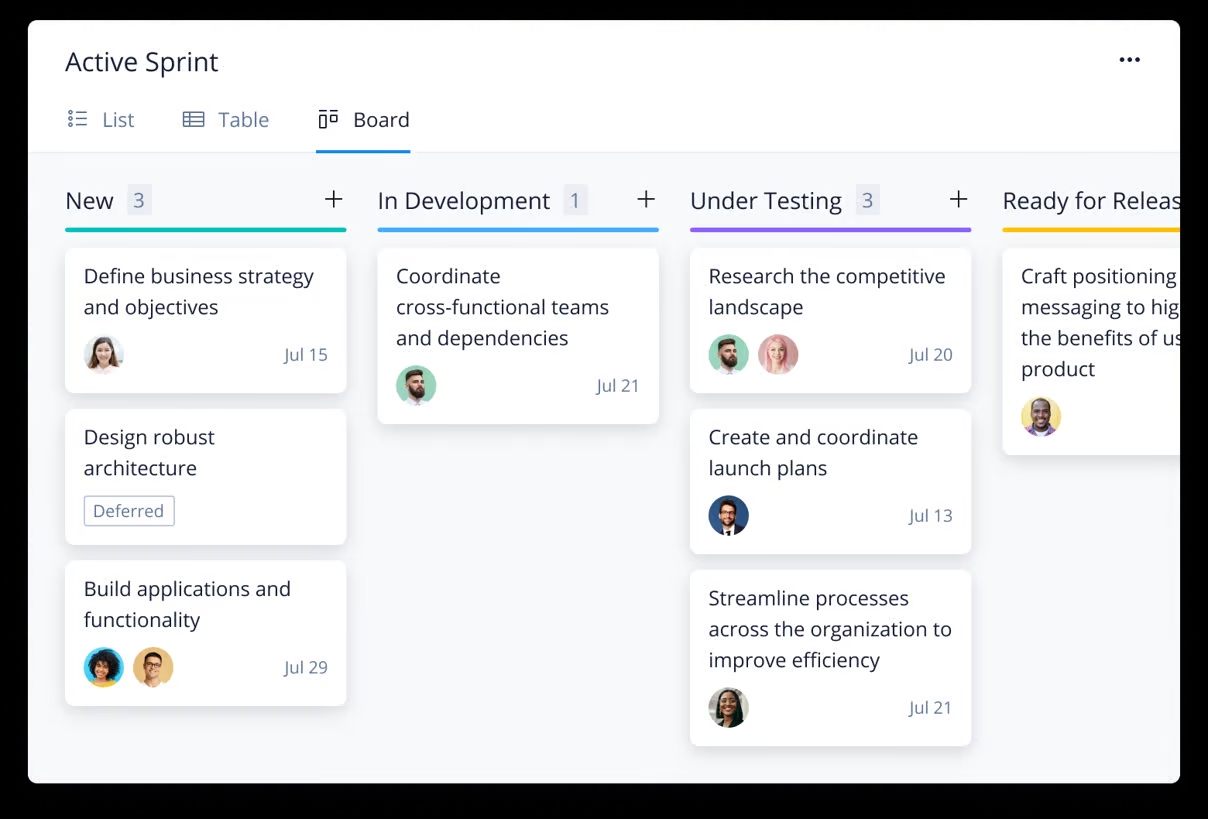

Marketing plan mistakes to avoid
Plenty of business marketing plans fall apart — not because the ideas were bad, but because of simple mistakes that could have been avoided.
Here are the biggest pitfalls global marketers should watch out for:
- Unclear goals: If you don’t define what success looks like, how will you measure it? Every marketing plan needs specific, measurable goals.
- Generic target audience: It’s tempting to market to “everyone,” but that’s a surefire way to waste resources.
- Lack of budget: A strong plan means nothing if there’s no budget to support it. Allocate funds wisely and adjust as needed.
- No market research: Making assumptions about your competitors instead of relying on data is a costly mistake. Market research should guide every decision.
A marketing plan should be a roadmap, not a rough idea. Avoid these mistakes, and you’ll set your team up for success instead of setbacks. Now, let’s look at where marketing is headed next.
Latest marketing plan trends
Marketing is evolving fast, and staying ahead means adapting to what works now. Here are the trends shaping marketing plans in 2025.
Artificial intelligence
AI is no longer a futuristic concept — it’s here. Companies are using AI to tailor content, automate tasks, and improve customer experiences. According to HubSpot’s 2025 State of Marketing Report, 47% of marketers understand how to use AI in their marketing strategy. Also, one out of five marketers plan to explore using AI agents to automate marketing initiatives from end-to-end strategy to execution.
Kieran Flanagan, SVP of Marketing, HubSpot, shared:
”AI allows you to go from A/B testing to A to Z testing, and quickly find out which ads or posts are the most likely to perform the best with your audience.’’
First-party data
With Google phasing out third-party cookies, brands are being forced to rethink how they collect customer data. According to Salesforce’s State of Marketing Report, customer insight, first-party, and transactional data are the top three data sources used by 84% of marketing leaders.
Brands are shifting toward zero-party data collection, meaning they directly ask customers for their preferences (e.g., interactive quizzes, preference centers). This builds trust and engagement while staying compliant with evolving privacy laws.
Short-form video
Video content is the most engaging form of content, and short-form videos are leading the way. According to HubSpot research, 41% of video marketers say that overall ROI from video marketing is high and 32% claim that video ROI is better than other types of content. Platforms like TikTok, Instagram Reels, and YouTube Shorts have shifted how audiences consume content.
Sustainability marketing
Consumers and businesses alike are prioritizing sustainability, making it a core pillar of marketing plans. Brands that embrace sustainability messaging and back it up with action are seeing stronger customer loyalty.
Make your marketing plan successful with Wrike
Now that you’ve learned how to build a results-driven marketing plan, it’s time to put your strategy into action. With Wrike, you can streamline your entire marketing strategy, from planning to execution.
Need to assign tasks, manage deadlines, or track performance? Wrike’s marketing plan templates can help you stay organized and adapt quickly as your business evolves.
Use these templates to streamline your marketing efforts:
- Competitor analysis marketing plan template to establish your business above the competition
- Marketing calendar template to schedule campaigns and track key dates
- Go-to-market strategy template to coordinate launch tasks and measure success
- Marketing campaign management template to track objectives and monitor your messaging
- Marketing promotion template to execute and monitor promotional campaigns
- Media management template to track content creation, approvals, and performance metrics
- Content operations template to manage editorial calendars and collaborate with your team


Marketing plan FAQs
Start with market research to understand demand, competitors, and pricing.
Focus on brand awareness and cost-effective tactics like content marketing, organic social media, and networking.
Your marketing plan should outline your audience, key messaging, pricing, promotional tactics, and budget, fitting into the overall business strategy.
Align marketing with company goals, define customer personas, choose marketing strategies that fit your industry, and create a performance tracking system.
Use low-cost, high-impact tactics like local SEO, referral programs, and partnerships. Focus on customer retention and personalized marketing efforts.
Define your business objectives. Understanding what you want to achieve shapes the rest of your plan.
A business plan covers everything — operations, finances, and growth strategy. A marketing plan focuses specifically on how to attract and convert customers.
A marketing plan keeps efforts focused, ensures budget efficiency, and provides measurable benchmarks to track progress.
Common mistakes include not researching your audience, setting vague goals, ignoring analytics, and failing to update the plan as the market evolves.
It can generate outlines, suggest tactics, and help with messaging, but strategic decisions and execution still require human expertise.
AI can analyze data, automate campaigns, and optimize strategies, but it lacks human creativity and real-world business judgment.
These are specific, measurable goals, like increasing brand awareness, generating leads, improving customer retention, or boosting sales.

